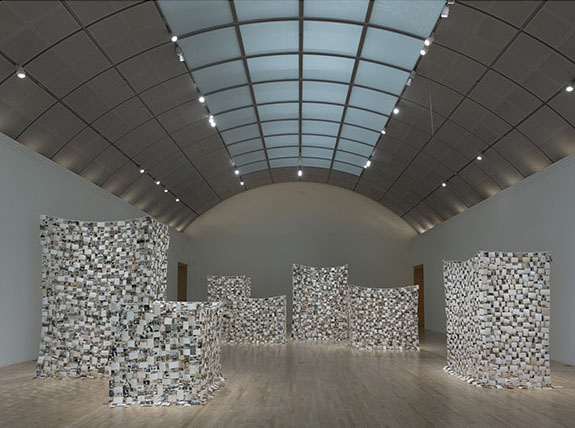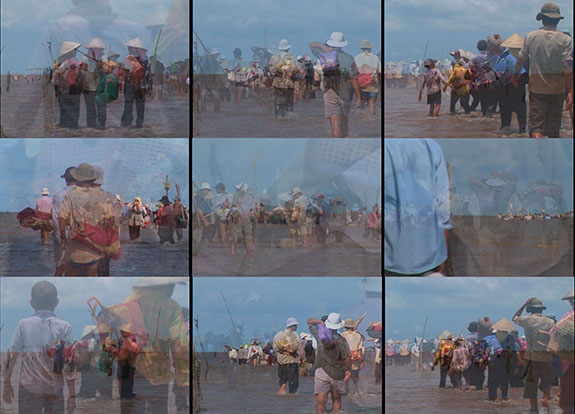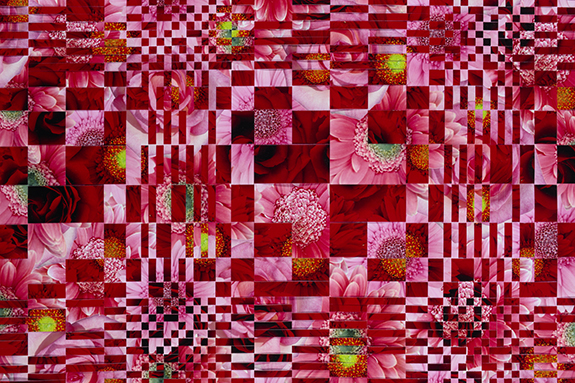by Patricia Albers

“On the morning of the tenth day at sea, I awoke to the sound of that old man asking for help to push the young man’s dead body into the water.” Those words, spoken by a former Vietnamese boat person, are scrawled across the back of a snapshot. It’s one of hundreds in Dinh Q. Lê’s installation Crossing the Further Shore, the emotional magnet and centerpiece of his exhibition True Journey is Return.
Battered and yellowed, the snapshots are loosely stitched together into seven boxy enclosures, which dangle from the ceiling in a bare-walled gallery. According to the artist, they allude to the mosquito nets under which he and other refugees slept in the camps they transited after fleeing Vietnam. Eventually Lê arrived in the U.S., where he spent 18 years. In 1996, he moved back to Vietnam. There he hunted for the family pictures his parents had left behind. That search proved fruitless. But Lê stumbled upon, then began seeking, other families’ pictures. 
Many of the snapshots in Crossing the Further Shore are turned inward, revealing the handwritten quotes on their backs. Some come from oral history interviews with Vietnamese-Americans remembering their own displacements. Others are lines from The Tale of Kieu, the epic poem that is the masterwork of Vietnamese literature. The Tale of Kieu interweaves themes of love, destiny, adversity, and endurance. Many Vietnamese can recite by heart its opening lines, and it’s easy to imagine refugees doing just that during their arduous journeys. Thus the poem too is pressed into service in the impossible task of coming to terms with the exodus and its aftermath.
Lê’s installation pulls its emotional power from the poignancy inherent in the family snapshot. To take such a picture is always to anticipate loss: this graduation party, this sunny afternoon, this sweet moment, will vanish forever. Let’s at least hold on to its material trace. Hold on as long as we can. Of the only photograph in which his parents appear together, the theorist Roland Barthes writes that “it is love-as-treasure which is going to disappear forever; for once I am gone, no one will any longer be able to testify to this: nothing will remain but an indifferent Nature.” This piece brings to the fore that realization. Seemingly out of reach of anyone’s loving memories, the pictures have become prompts for speculation about their subjects’ then-future past. Did this person die? Might she still be alive? What and where is she now? All faded portraits of strangers stir such questions, but in the context of the terror and chaos that ravaged Vietnam, they’re amplified.

At one point in what the Vietnamese call the American War and Americans call the Vietnam War, the U.S. military adopted a policy of systematically torching villages, obliterating people’s homes to deprive the enemy of hiding places. Lê’s photos, presented on freestanding rectangular structures feel like their ghosts. What’s more, after the North Vietnamese victory in 1975 the new government began systematically wiping out the records, visual and otherwise, of what had been South Vietnam. That makes Crossing the Further Shore not only an artwork but also a historically significant archive.
There’s a second installation here, a video work titled The Imaginary Country. It positions viewers between a 3-channel projection and a single-channel projection, forcing their attention to shift back and forth. The former weaves together footage of Vietnamese clam diggers wading into the ocean just as the boat people once waded out to the vessels that carried them away. The latter presents young people from the diaspora who have traveled to Vietnam and are struggling to articulate their responses to a “homeland” they know mostly from family stories. It’s this piece that most effectively attests to the point made by the exhibition’s title: True Journey is Return. Borrowed from The Dispossessed, an Ursula LeGuin novel inspired by the Vietnam War, it points to the complexities of going back.

Like all the works in Lê’s exhibition, The Imaginary Country meshes present and past, the individual and the collective, to evoke lives and cultures ceaselessly reconfigured. That theme is most literal in the Tapestry series of the photo-weavings in which the artist plaits strips of photographs with floral motifs. Inspired by traditional Vietnamese grass weaving, these reference Op Art even as they constitute visual intertexts that slip between the globalized and the traditional, mourning and joy.
A third gallery houses two multimedia pieces that combine drawings, paintings, and video to address the experiences of North Vietnamese artists during the war. It’s here that the exhibition becomes ragged. The more engaging of the two, Light and Belief: Voices and Sketches of Life from the Vietnam War, includes ink sketches and watercolors by North Vietnamese artist-soldiers answering leader Ho Chí Minh’s call “to fight on the battlefield of cultural ideology.” These same artist-soldiers, now elderly, describe their experiences in a video that puzzlingly alternates between live footage and animation. While the work has the merit of humanizing those once demonized in the U.S., it feels didactic. To borrow from Barthes, it is all studium – historical interest – as opposed to the punctum – the emotional wound – of Crossing the Further Shore.

In a world with over 68 million forcibly displaced people and with an administration that has capped refugee admissions at 45,000 in the past fiscal year but accepted fewer than 22,000, Lê’s thicket of photographs shows all over again what art can do and politics can’t. “Each getting here is a narrative entanglement of memory and history and emotions and pain and joy and guilt and ideas undone and reborn,” writes the Bosnian-born Aleksander Hemon of “the vast narrative landscape” that is the refugee experience. Lê’s work brings that home that understanding. He has it right: true journey is return.
# # #
Dinh Q. Lê: True Journey is Return @ San Jose Museum of Art through April 7, 2019.
About the Author:
Patricia Albers is a Bay Area writer, art historian, and teacher. Her books include "Joan Mitchell, Lady Painter: A Life" and "Shadows, Fire, Snow: The Life of Tina Modotti." She is currently working on a biography of photographer André Kertész.